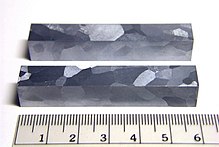Vanadium

Vanadium is chemical element 23 on the periodic table. Its symbol is V. It is a metal and is part of the group known as the transition metals. It is gray-blue colored. It is mostly used in steel where it helps strengthen the steel metal. It is named after Vanadis, another name of Freyja.
Vanadium is often found in aquatic forms of life. The human body may need a little bit of vanadium, but scientists are not sure.
Vanadium can react with many other elements, and the chemical compounds it forms often have beautiful colors.
History[change | change source]
Vanadium was found for the first time in 1801 in Mexico by the Spanish mineralogist Andrés Manuel del Río in an ore called "brown lead". He named it panchromium because of the beautiful colors in its chemical compounds. He was told by other people that it was chromium and so he stopped researching it.[1]
In 1831 Swedish chemist Nils Gabriel Sefström found the element in iron ores. The German chemist Friedrich Wöhler said it was the same element that del Río found in 1801. The element was then named vanadium.
Occurrence[change | change source]
The amount of vanadium in the Universe is 0.0001%, making the element almost as common as copper or zinc.[2] Vanadium is detected by spectroscopy in light from the Sun, and sometimes in light from other stars.[3]
Vanadium is the 22nd most common element in the Earth's crust.[2] Metallic vanadium is rare in nature.[4][5] Vanadium compounds occur naturally in about 65 different minerals. Most of the world's vanadium production comes from vanadium-bearing magnetite found in ultramafic gabbro rocks. Vanadium is mined mostly in South Africa, north-western China, and Eastern Russia. In 2013 these three countries mined more than 97% of the 79,000 tonnes of produced vanadium.[6]
Vanadium is also in bauxite and in deposits of crude oil, coal, oil shale and tar sands.
Properties[change | change source]
Vanadium is soft compared to other metals. It is a good conductor of electricity and heat. It can be pulled out into wires (ductile). Pure vanadium will form a layer of vanadium oxide corrosion very fast.
Uses[change | change source]
A lot of vanadium (85%) is used to make different types of steel. Steel made with vanadium is stronger. It is also mixed with titanium to make metal alloys that are used in jet engines and tooth implants.
Vanadium is also used to make batteries.
In nature[change | change source]
Vanadium is used by several marine organisms. Some algae and bacteria (like Azotobacter) use it for nitrogen fixation.[7]
References[change | change source]
- ↑ Cintas, Pedro (2004-11-12). "The Road to Chemical Names and Eponyms: Discovery, Priority, and Credit". Angewandte Chemie International Edition. 43 (44): 5888–5894. doi:10.1002/anie.200330074. ISSN 1433-7851. PMID 15376297.
- ↑ 2.0 2.1 Rehder, Dieter 2008 (2008). Bioinorganic vanadium chemistry. Inorganic Chemistry (1st ed.). Hamburg, Germany: John Wiley & Sons, Ltd. pp. 5 & 9–10. doi:10.1002/9780470994429. ISBN 9780470065099.
{{cite book}}: CS1 maint: numeric names: authors list (link) - ↑ Cowley C.R. et al 1978 (1978). "Vanadium abundances in early A stars". Publications of the Astronomical Society of the Pacific. 90: 536. Bibcode:1978PASP...90..536C. doi:10.1086/130379. S2CID 121428891.
{{cite journal}}: CS1 maint: numeric names: authors list (link) - ↑ Ostrooumov M. and Taran Y. 2015. Discovery of native vanadium, a new mineral from the Colima Volcano, State of Colima (Mexico). Revista de la Sociedad Española de Mineralogía 20, 109-110
- ↑ "Vanadium: Vanadium mineral information and data". Mindat.org. Retrieved 2016-03-02.
- ↑ Magyar, Michael J. "Mineral Commodity Summaries 2015: Vanadium" (PDF). United States Geological Survey. Retrieved 3 June 2015.
- ↑ Rehder, Dieter (2019-12-18). "Vanadium: Biological, Environmental, and Engineering Aspects". Advances in Chemical Research. 2 (1): 1. doi:10.21926/acr.2001002. S2CID 214053167.
| H | He | ||||||||||||||||||||||||||||||||||||||||
| Li | Be | B | C | N | O | F | Ne | ||||||||||||||||||||||||||||||||||
| Na | Mg | Al | Si | P | S | Cl | Ar | ||||||||||||||||||||||||||||||||||
| K | Ca | Sc | Ti | V | Cr | Mn | Fe | Co | Ni | Cu | Zn | Ga | Ge | As | Se | Br | Kr | ||||||||||||||||||||||||
| Rb | Sr | Y | Zr | Nb | Mo | Tc | Ru | Rh | Pd | Ag | Cd | In | Sn | Sb | Te | I | Xe | ||||||||||||||||||||||||
| Cs | Ba | La | Ce | Pr | Nd | Pm | Sm | Eu | Gd | Tb | Dy | Ho | Er | Tm | Yb | Lu | Hf | Ta | W | Re | Os | Ir | Pt | Au | Hg | Tl | Pb | Bi | Po | At | Rn | ||||||||||
| Fr | Ra | Ac | Th | Pa | U | Np | Pu | Am | Cm | Bk | Cf | Es | Fm | Md | No | Lr | Rf | Db | Sg | Bh | Hs | Mt | Ds | Rg | Cn | Nh | Fl | Mc | Lv | Ts | Og | ||||||||||
| |||||||||||||||||||||||||||||||||||||||||
